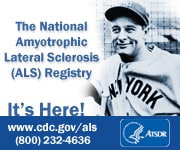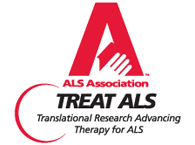Tuesday, November 17, 2009
Smoking May Now Be Considered An Established Risk Factor For ALS, Also Known As Lou Gehrig's Disease
While previous studies have indicated a "probable" connection between smoking and ALS, a new study published in the Nov. 17, 2009 issue of Neurology®, the medical journal of the American Academy of Neurology, states that smoking may now be considered an "established" risk factor for Amyotrophic Lateral Sclerosis (ALS), also known as Lou Gehrig's disease.
The findings come from Baystate Medical Center neurologist Dr. Carmel Armon, an ALS researcher and neuroepidemiologist, who came to this conclusion using evidence-based methods to perform a rigorous analysis of studies examining the link between smoking and developing ALS -- a fatal neurodegenerative disease affecting the motor nerves and the voluntary muscles.
"Application of evidence-based methods separates better-designed studies from studies with limitations that may not be relied on. The better-designed studies show consistently that smoking increases the risk of developing ALS, with some findings suggesting that smoking may be implicated directly in causing the disease," said Dr. Armon, a professor of neurology at Tufts University School of Medicine and chief of neurology at Baystate Medical Center in Springfield. He is also a fellow of the American Academy of Neurology.
According to Dr. Armon, identifying smoking as an established risk factor for ALS has three implications.
"First and foremost the findings provide a link between the environment and the occurrence of ALS, where none had been previously identified with this level of certainty," said Dr. Armon.
"Additional implications are that since smoking has no redeeming features, avoidance of smoking may reduce the occurrence of ALS in the future, and since some of the mechanisms by which smoking causes other diseases in humans are understood fairly well, recognizing its role in the occurrence of ALS may help pinpoint the biological processes that initiate the disease," added the researcher.
The Baystate Medical Center neurologist noted that focusing on processes at initiation of sporadic ALS, and close to it, may provide new avenues to treatment to stop its progression.
"This has been realized in some animal models of familial ALS, but not in humans. The hope that these concepts may apply to sporadic disease and change its outlook in the future is supported by establishing the association of smoking with ALS occurrence," concluded Dr. Armon.
ALS takes the lives of half of those affected within three years of onset of weakness, with less than five percent surviving more than 10 years. Some 90-95 percent of cases appear to occur at random ("sporadic cases'), with 5-10 percent of cases having an affected blood relative ("familial cases"). An altered gene, several of which have been identified, is implicated in causing familial ALS. Prior to this report, no external factors have been implicated with this level of confidence as contributing to the occurrence of sporadic ALS.
Thursday, November 12, 2009
Nobody Tells a Dying Guy to Shut Up

Dave Chilcoat and his wife Beth came to Columbus, Ohio, in 1970 to start Young Life, a ministry dedicated to introducing adolescents to Christ. Ten years later, he felt called to law school and subsequently practiced law for 25 years. Blessed with work, four kids, (then) six granddaughters, golf to play and plenty of Pittsburgh sports on TV - Dave’s life was full.
In 2003, Dave was diagnosed with ALS (Lou Gehrig’s disease). With that diagnosis, Dave and Beth’s circumstances changed dramatically, but their God did not.
Day by day, as ALS literally stole Dave’s health and strength, they watched the amazing miracle of God giving each of them spiritual strength in even greater abundance. Together they came to know God’s joy and His enabling power as He walked them though those difficult years.
Faced with the reality of death, Dave chose life. He captured and commented on the experience of living in dying through an online journal, a candid account of parallel progression - physical decay and spiritual growth. Dave wrote weekly for nearly three years and his chronicle was read by tens of thousands around the world. Like the Psalmist, he described his situation, poured out his heart and witnessed to God’s presence in it all.
Beth compiled this journal excerpt, which follows the progression of the disease, highlights their devotion to one another, and continues Dave’s remarkable expression of love for and faith in Jesus Christ with intensity and humor.
Dave taught thousands how to live through his Young Life ministry, speaking and teaching, and day-to-day faith. With this book he guides us through death into new life, trusting in the power of God’s love.
Tuesday, November 10, 2009
Michael Goldsmith Remembered
On July 4, 2009 Major League Baseball launched an ALS Awareness campaign, commemorating the 70th anniversary not just in Yankee stadium, but also in every league ballpark where baseball was played that day. And MLB pledged that the anniversary events were just the beginning of an ongoing commitment to the ALS cause.
Michael Goldsmith had grown up in New York, made what he knew was likely his final trip to his hometown. He took the field in Yankee Stadium and threw out the ceremonial first pitch to a standing ovation. “ALS robs us of our future, MLB’s decision has produced renewed hope.”
He knew, of course, that any hope would come too late for him. On Sunday, Nov. 1, one year to the date that his essay appeared in Newsweek, Michael Goldsmith died of respiratory failure due to ALS.









